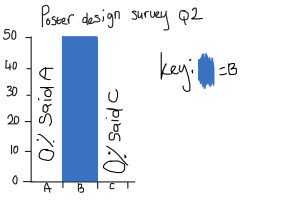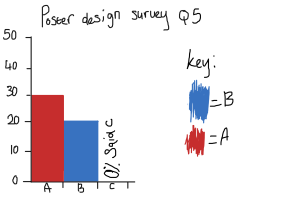UAL Awarding Body
UAL Level 3 Diploma and Extended Diploma in Art & Design
Student Assessment Feedback Form
| As Assignment Title | National Student Survey 2016 Competition Live Brief |
| Unit No & Title | Unit 1: Introduction to Visual Language (12 x L3 Credits)
Unit 2: Introduction to Research Skills (12 x L3 Credits) Unit 4: Introduction to Materials, Process & Skills (12 x L3 Credits) |
| Student Name | Kiera Bennett |
| Tutor Name | Niall Bruckshaw |
| Assessment Date | Monday 14th September – Friday 30th October 2015 |
| Task & Assessment Criteria | Tutor Feedback | |
| 1 | Context & Research
U1 1.1 – Critically compare the characteristics of visual language U1 2.1 – Apply visual language to influence appearance and meaning. U1 2.2 – Critically compare the use of visual language to influence appearance and meaning. U2 1.1 – Critically compare a range of research tools, methods and skills. U2 2.1 – Critically compare a range of primary and secondary research sources. U2 3.1 – Apply research tools to record, interpret and develop ideas. |
Good analysis of brief reqs. Good work on contextual research on NSS/NUS however you missed the opportunity to analyse how it could help in your design work e.g. “I could implement a timeline, history, lgbt, women rights, digital element into my poster design.”
Good use of RoC in poster analysis. I really like the use of overall thoughts section in your research. Be careful of spelling, analyse (UK) vs. analyze (USA). Good focus on colour and space. For distinction just look at more visual elements and principles. Excellent detailed investigation of history of posters. If you had used images to back up your statements that would’ve been distinction. Artist research was good. Still a focus on colour but some discussion on texture was interesting. Very good investigation of type but again pictures of the various typefaces would’ve helped your point. Interesting primary research survey with good presentation. In the future, to get a good accurate sample population you will need more than 5 people. Plan ahead for this and use SurveyMonkey. Very descriptive mood board. Mind map could’ve had more than 7 ideas. |
| 2 | Planning, Problem Solving, Skills & Design
U1 1.1 – Critically compare the characteristics of visual language U1 2.1 – Apply visual language to influence appearance and meaning. U1 2.2 – Critically compare the use of visual language to influence appearance and meaning. U4 1.1 – Critically compare a range of materials and processes U4 1.2 – Apply understanding of materials and processes. U4 1.3 – Apply understanding of technical skills. |
Would’ve liked more than 7 preliminary sketches with more detailed annotations for higher marks. Now fixed well done
For your developed ideas, less explanation on how you made the posters and more explanation about why you did it in certain ways would be better. For distinction grades in the future you will need more than 2 dev sketches as well. On your final design, pay more attention to layout in future. You are definitely right about the blue, and it is good but would benefit from the small print being smaller, the partner logos and QR code being at or nearer the bottom as they draw too much attention and the graphic needs that attention more. Logos moved, QR code should ideally be same size as other logos for consistency. They could have been centered as well. Small print needs to be differentiated from other text by being small. The blue background is the right choice, the blue for the text isn’t, white would’ve been perfect or another colour from a triad colour scheme with blue or even the light grey blue you have used for the screens in the graphic. The graphic is great and well-made but could’ve been cleaner on the right hand side hand where it falls over the screen. I’m not 100% certain about your strapline but it’s a good effort. |
| 3 | Evaluation & Reflection
U1 1.1 – Critically compare the characteristics of visual language U2 1.1 – Critically compare a range of research tools, methods and skills. U2 2.1 – Critically compare a range of primary and secondary research sources. U2 3.1 – Apply research tools to record, interpret and develop ideas. U2 3.2 – Evaluate the effectiveness of research tools to develop ideas. U4 1.4 – Evaluate the use of materials, processes and technical skills. |
Don’t include my questions in your evaluation in future. It’s neater if its laid out in paragraphs.
Correct about Wikipedia, avoid it unless you cant find anything else. Correct about more images. I understand your point about Olly Moss colour scheme but experiment with different ones in future. Make sure you state which typeface you ended up using. Again, I understand your point about colour harmony with the use of lots of blues for text as well as background colour but to really get the effect you were going for look at the comments above. Good discussion of target audience and technique. You could tidy up your references as well. You don’t need subtitle letters, just list them in alphabetical order. |
Comments |
|
Student working at Grade |
MERIT/DISTINCTION borderline. |
| Areas for improvement
Pay more attention to layout in future. Now fixed well done. Spend a little bit more time on presentation of blog posts e.g. eval and references. Now fixed well done More preliminary sketches with more annotations. Now fixed well done More detail on visual analysis.
|
|
| Tutor Signature | Niall Bruckshaw |
| Date | 29/10/2015 |
| IV Signature | Neil Matthews |
| Date | 30/10/2015 |
| Candidate Authentication | Learner statement of authenticity
I confirm that the attached portfolio is all my own work and does not include any work completed by anyone other than myself. |
| Student Signature | Kiera Bennett |





















